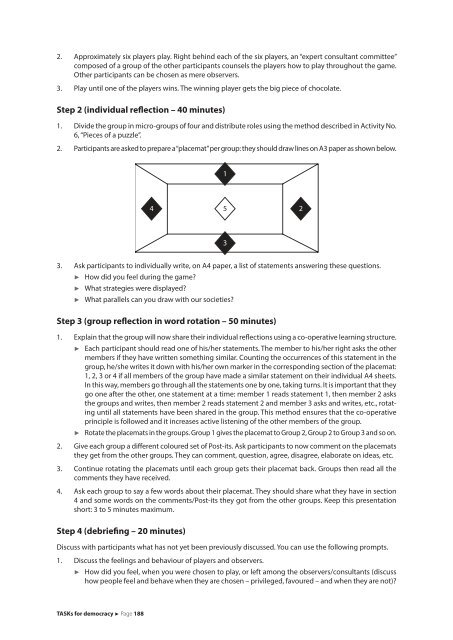TASKs for democracy
4NYw4W
4NYw4W
You also want an ePaper? Increase the reach of your titles
YUMPU automatically turns print PDFs into web optimized ePapers that Google loves.
2. Approximately six players play. Right behind each of the six players, an “expert consultant committee”<br />
composed of a group of the other participants counsels the players how to play throughout the game.<br />
Other participants can be chosen as mere observers.<br />
3. Play until one of the players wins. The winning player gets the big piece of chocolate.<br />
Step 2 (individual reflection – 40 minutes)<br />
1. Divide the group in micro-groups of four and distribute roles using the method described in Activity No.<br />
6, “Pieces of a puzzle”.<br />
2. Participants are asked to prepare a “placemat” per group: they should draw lines on A3 paper as shown below.<br />
1<br />
4 5<br />
2<br />
3<br />
3. Ask participants to individually write, on A4 paper, a list of statements answering these questions.<br />
<br />
<br />
<br />
How did you feel during the game?<br />
What strategies were displayed?<br />
What parallels can you draw with our societies?<br />
Step 3 (group reflection in word rotation – 50 minutes)<br />
1. Explain that the group will now share their individual reflections using a co-operative learning structure.<br />
<br />
<br />
Each participant should read one of his/her statements. The member to his/her right asks the other<br />
members if they have written something similar. Counting the occurrences of this statement in the<br />
group, he/she writes it down with his/her own marker in the corresponding section of the placemat:<br />
1, 2, 3 or 4 if all members of the group have made a similar statement on their individual A4 sheets.<br />
In this way, members go through all the statements one by one, taking turns. It is important that they<br />
go one after the other, one statement at a time: member 1 reads statement 1, then member 2 asks<br />
the groups and writes, then member 2 reads statement 2 and member 3 asks and writes, etc., rotating<br />
until all statements have been shared in the group. This method ensures that the co-operative<br />
principle is followed and it increases active listening of the other members of the group.<br />
Rotate the placemats in the groups. Group 1 gives the placemat to Group 2, Group 2 to Group 3 and so on.<br />
2. Give each group a different coloured set of Post-its. Ask participants to now comment on the placemats<br />
they get from the other groups. They can comment, question, agree, disagree, elaborate on ideas, etc.<br />
3. Continue rotating the placemats until each group gets their placemat back. Groups then read all the<br />
comments they have received.<br />
4. Ask each group to say a few words about their placemat. They should share what they have in section<br />
4 and some words on the comments/Post-its they got from the other groups. Keep this presentation<br />
short: 3 to 5 minutes maximum.<br />
Step 4 (debriefing – 20 minutes)<br />
Discuss with participants what has not yet been previously discussed. You can use the following prompts.<br />
1. Discuss the feelings and behaviour of players and observers.<br />
How did you feel, when you were chosen to play, or left among the observers/consultants (discuss<br />
how people feel and behave when they are chosen – privileged, favoured – and when they are not)?<br />
<strong>TASKs</strong> <strong>for</strong> <strong>democracy</strong> Page 188


